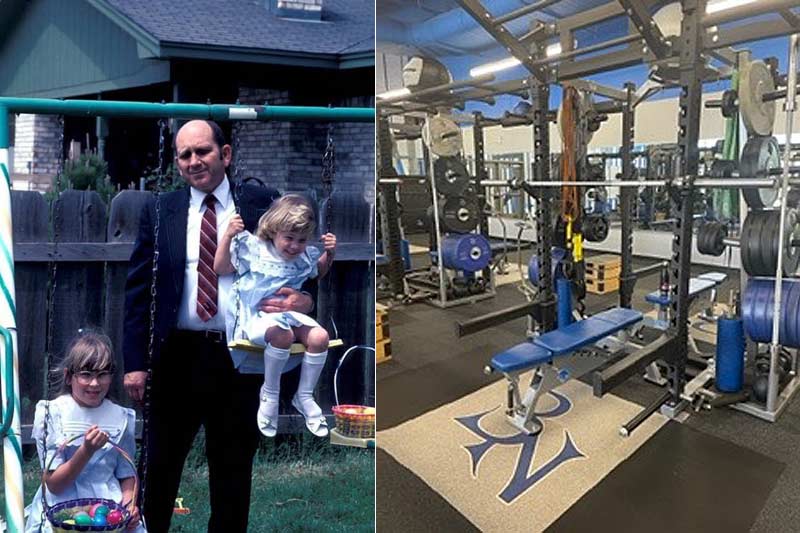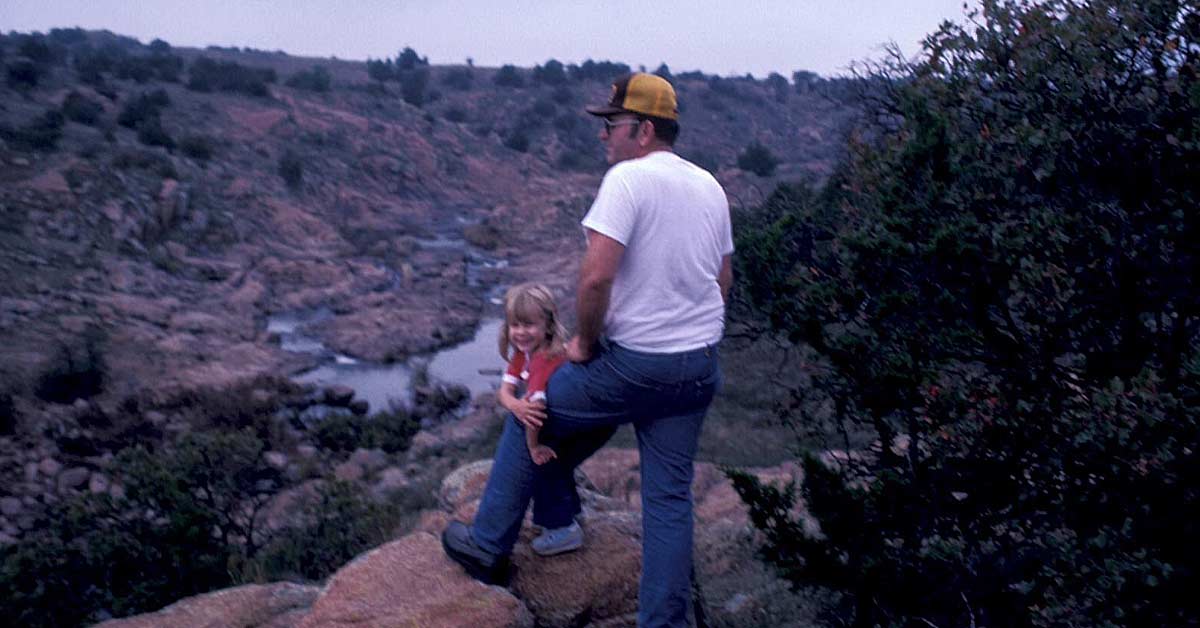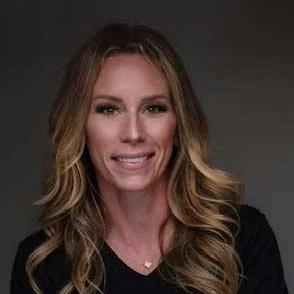On Thursday, March 15, 2012, I received the phone call that my father had passed away. The days that followed will be forever burned into my memory. On the 16th, we made the funeral arrangements. On the 17th, I labored over the perfect words to say from the podium above my father’s casket. On the 18th, we visited with friends and family at the funeral home. On the 19th, we buried my dad.
By the 20th, I couldn’t stand it anymore—I had to go lift. I wasn’t able to go to my weight room due to lack of proximity, so my husband took me up to the fieldhouse at his school to give me the chance to lift. Tears of sadness and anger streamed down my face, but I lifted. However cathartic the moment was, it would be foolish to pretend this made a dent in the devastation that I felt—but it was the first step along the path to normalcy in my life.
A decade later, on March 16, 2022, I found myself in a weird headspace. In addition to the recent 10-year anniversary of the sudden loss of my father, I had a friend unexpectedly depart my life. Despite, from my perspective, no apparent cause—and along with a continued effort on my part to reach out—all communication abruptly stopped. I found myself confused and devastated. I was at a loss as to how to handle these feelings, but one thing was clear: a start would be to go to my weight room at work and train.
It wasn’t until midway through my sets of pull-ups—which were going horribly, by the way—that I questioned why I chose to show up at work on a day off. Not like an existential why am I here? but rather an I get that I need to process some emotions right now, but why am I here specifically?
Hence the inspiration for this article.

In truth, every strength and conditioning coach has their preferred place to train and, taking it a step farther, their preferred platform. Between my two weight rooms, I have 30 platforms at my disposal, yet I use the same one every single time.
In truth, every strength and conditioning coach has their preferred place to train and, taking it a step farther, their preferred platform, says @missEmitche11. Share on XIt’s a place of solitude and strength. A place to experience success and, possibly more importantly, failure. No matter what is happening outside of that platform/rack, it’s a place you can go to escape it all or to process it, whatever the occasion calls for.
But this still hasn’t answered the question: why is one’s training space so special? Since I have the emotional intelligence of a gnat, I took to our industry’s leading source of wisdom to seek insight—Twitter.
The question I posed was as follows:
“S&C Coaches: tell me what life or career lessons you’ve learned through your own training and/or what value it brings to your life.”
Here are five responses that resonated with me. Each made me reflect on the range of ways I feel that training alone on one’s chosen platform can provide a deeply introspective experience, one that has the potential to elicit personal and professional growth.
Lesson #1. “PRs don’t sync up with promotions or pay increases.” –Donnell Boucher
cc: Young strength coaches!!
You’ll never see me argue that training in some form or fashion isn’t a critical piece of our jobs, but our identity as professionals needs to extend beyond that.
Nonetheless, this tends to be a polarizing topic in strength and conditioning: looking the part and whether athletes care how much you lift. On one end of the spectrum, you have Team cut-off sleeves holding 8 ounces of chicken in one hand and a printed list of their recent PRs in the other. At the opposite end, you have Team I don’t have time to lift because it’s all about training my athletes.
My take? As with many things in life, the truth lies somewhere in the middle.
Coaches should lead by example. This includes training within your current physical capacity. But we should also exemplify balance. Your personal workouts shouldn’t trump the needs of your athletes. One of the responses I received on Twitter on this topic was along the lines of “My sport is coaching. If I come into a session wrecked from my own workout? I’m not doing it right.”
Preach.
The reality is that your ability to build relationships, to communicate, and to develop the best prepared athletes for their sport will lead to career advancement. Not how much you bench, bruh. And to take this point a step further, your career advancement shouldn’t get in the way of cultivating relationships outside of work.
The reality is that your ability to build relationships, to communicate, and to develop the best prepared athletes for their sport will lead to career advancement. Not how much you bench. Share on XI stayed at work on a day I should have gone to see family (March 14, 2012). I opted to use my “get out of jail free” card on another date. It seemed like the right decision at the time but choosing to staff your desk over spending time with family rarely is. If you get nothing else from reading this article, please let my story be a reminder of that.
A second, and absolutely inevitable, reality is that you won’t always be able to train the way you did in your 20s. This brings us to a second life lesson learned on the platform.
Lesson #2. “Father Time is undefeated.” –Alan Bishop
My exact response: I hate that guy.
Because I do. As I discussed recently with a colleague, our bodies change as we age, but our hearts seemingly don’t. Despite two blown-out shoulders, I still have an itch to bench press. Despite a back issue caused by stupidity in my 20s, I still want to squat heavy.
But I don’t.
Instead, I modify around old injuries, spend more time warming up, and focus on movement capacity to prevent further injuries from occurring.
It seems like the right move, but it’s not without its own set of consequences. For example, as strength coaches, we pride ourselves on immaculate demonstrations, no warm-up required. We are cheetahs. We stay ready so we don’t have to get ready. We are flawless on the platform in front of athletes.
Until, one day we aren’t. One day, seemingly without warning, you hear that snap crackle pop in your elbow when demonstrating a clean pull, a movement your body no longer tolerates during training. (The pain is searing, but you don’t even flinch. You are a strength and conditioning professional; you demonstrate no weakness. Ironically, this was how you got hurt in the first place.) Your heart tells you this is an isolated incident, so you continue your idiotic ways.
As time goes on, you may start to realize these incidents are happening more frequently. You might have to practice what you preach to athletes and modify your own workouts, come into a team session more warmed up, or even *gasp* not demonstrate certain lifts.
The horror.
In all seriousness, this is the start of a big pivot in your coaching career, and one that I think can improve your communication skills. Since your body is failing you (relatively speaking), you’re going to have to figure out a way to show the visual learners in the group how to correctly execute a given exercise. You’re going to need a clear and concise system of walking one of your athletes through the correct execution of something they’ve potentially never done before.
If you’ve spent your whole career demonstrating, this can be a daunting task. If you’ve also spent your entire career feeling you must always get things right in front of athletes, you’re in for a bumpy ride. Prepare to use the following phrases in the early stages of this process:
“Sorry, I’m not explaining this very well.”
“You’re doing great. I’m just not used to teaching it this way.”
“NEVERMIND, I WILL DO IT.”
You may actually be amazed how relatable athletes find it when you throw yourself on your sword and say, “I can’t do this because of X” or “I am struggling teaching this.” They struggle in front of us all the time. It’s okay to reverse that role sometimes.
Despite my increased reliance on athlete demonstrations (I’d say I’m currently sitting at about a 60/40 me to them demo ratio), I do still keep a couple of aces up my sleeve to keep my street cred alive. At present, that’s making 1–2 strict pull-ups seem easy. Being a one-trick pony is a great workaround if you’re simply unable to give up your ego, as I have been. It also helps you stay focused on a long-term goal, which for me has changed dramatically from the earlier stages of my training career.
Instead of focusing on aesthetics and PRs, I’m now focusing on overall health. Remember our section title: Father Time is undefeated. He stops for no one. Waits for no one. Saves no one. If he would have told me on March 14, 2012, that my dad would pass away on the 15th, I would have taken a wholly different approach the 14th. I wouldn’t have waited to call or see my dad because I was headed out to my parents that weekend. I would have done it right then.
If you would have told me I would have two blown-out shoulders in my 30s, I’d like to think I would have modified my training in my 20s to attempt to avoid this. I wouldn’t have waited until I got injured. I would have done it right then.
Clearly, the impact of those two scenarios on my life really couldn’t be farther apart on a map, but the lesson is the same: prioritize the long-term goal because in the end the end is the end.
Focusing on the long-term goal is a good tie-in to our next lesson.
Lesson #3. “Boredom: We preach ‘the process’ to kids but never bother to embrace how monotonous training actually is.” –Tim Kettenring
Rather than sticking to a program over the course of time, coaches often program-hop in their own training despite the knowledge that consistent training will yield better results in the long term and lessen the likelihood of injury.
Think about that concept in the context of career growth or relationships. Rather than seeking that short-term dopamine hit that comes from the thrill of something new and different (but superficial), invest in things that stand the test of time. Invest in consistency. It’s boring, but it’s usually exactly what we need. Relationships can be challenging, as I’m currently experiencing, but the real ones are worth the frustration in the long run.
If you’re chronically in search of greener pastures, the problem may not be your current circumstance; the problem may be in your evaluation of your current circumstance, says @missEmitche11. Share on XIn the context of career growth, how often do we see strength and conditioning coaches hopping jobs? Sometimes it’s a necessary evil. However, if you’re chronically in search of greener pastures, the problem may not be your current circumstance; the problem may be in your evaluation of your current circumstance. Think of every time you’ve had an athlete request a new or “special” program when they are executing their current one with very little intent. This may be exactly what you’re doing seeking a different career opportunity.
Additionally, you’re probably missing the boat on learning how to develop athletes over a four- to six-year time frame. I’ve seen coaches never stay anywhere more than 1–2 years. Are they really adept at athlete development? How much traction can you get in that time frame? Again, I’ll ask: is the circumstance the problem in these job-hopping situations, or is it the coach in question?
Where it comes to relationships, “program hoppers” are ones discarding people by the wayside as they seek out the new and more fun. Rather than understanding and embracing the ebbs and flows that come with long-term relationships, they are quick to jump ship when things don’t go their way or to move on when the newness wears off in their current relationship.
In all three contexts—the weight room, a career, and relationships—“program hopping” is a fast track to a potential catastrophic injury. While you may not feel motivated to stay the course through what can be mundane and downright difficult, you need the discipline to do so to be successful in most aspects of life.
Lesson #4. “Two-hundred pounds is always 200 pounds.” –Monte Sparkman
This may seem like a simple concept, and it is. It’s also a powerful one.
The weight room is the most honest space in the world. The weights don’t care who you are, how you feel, or about your problems. They still weigh the same. There’s comfort in this truth, comfort in the fact that you typically get closure in the weight room. You either got the lift or you didn’t, and further adding to your sense of closure, you can usually pinpoint one or more causes of a missed attempt.
The weight room is the most honest space in the world. The weights don’t care who you are, how you feel, or about your problems. They still weigh the same. There’s comfort in this truth. Share on XThis is not as often the case in life, where feedback is not always so immediate and clear-cut. Root causes of issues can be much more complex, and you may have to do a tremendous amount of introspection in order to create a sense of closure for yourself. To use my own circumstance as an example, I may never have an answer for why my friend has stonewalled me. Instead, I may have to find a way to move on and gain closure for myself rather than receiving an explanation that might provide closure to me.
Life is filled with gray areas, and everyone needs a place where they can escape and recharge. The platform can provide the perfect outlet for this due to its black-and-white nature and the steadfast truth that the weights will always give back what you put into them. Careers may not. Relationships may not. But the weights always will.
Lesson #5. “There are two things in life that cause injury, whether in the weight room, in finances, or in relationships: 1) poor form and 2) ego.” –Christopher Lacey
Mic. Drop.
However, I do want to reverse the order of the two causes of injury for purposes of this discussion: ego first, then poor form.
Or, more appropriately, ego leading to poor form.
How many times have you seen it on the platform? Somebody wants that big 1RM squat, so they cut depth. They want to live that PR tug life, so they throw a C-shaped curve in their spine and pull with everything they’ve got, intervertebral discs screaming all the way. Their ego is greater than their ability, and the consequences can be disastrous.
This could not be more applicable in our careers. A strength coach heads into the first meeting with a new head coach, ego barely fitting through the door. They present their obviously correct training methodology only to reach a philosophical impasse with the equally large ego sitting across the desk from them. Someone commits a slight breach in etiquette during the meeting, and both parties leave furious.
What gets injured?
A relationship, and potentially the quality of the athletes’ experience. A better way is to negotiate a compromise. This may not happen on Day 1, but it can be reached through hard work, appropriate “form” in workplace interactions, and the development of a solid working relationship.
The same can be said in personal relationships. If we behave poorly, or our behavior is perceived poorly by the other party, we are likely to damage that relationship. We might even end it entirely. If it’s a relationship we value? The aftermath can be crippling, just like the aftermath of a training-related injury. Just like the aftermath of my ended friendship that led to the inspiration for this article.
More Than Just a Platform
I recently saw a tweet where a coach said that the overarching purpose of high school sports was for athletes to secure a spot on a collegiate roster. I was horrified.
I believe the overarching purpose of athletics is to provide opportunities to become a better human being. To learn consistency, discipline, adaptability, humility, and much more, says @missEmitche11. Share on XI believe the overarching purpose of athletics is to provide opportunities to become a better human being. To learn consistency, discipline, adaptability, humility, and much more. These are the lessons I believe those of us who have chosen the profession of strength and conditioning have learned through our own training, and the ones we hope to pass on to the athletes we train.
The platform may not succeed in imparting these attributes to every person who sets foot on it, but to those of us that it has, it is our sanctuary. It is a place we go to grow, to reflect, and in my current circumstances, to grieve.






